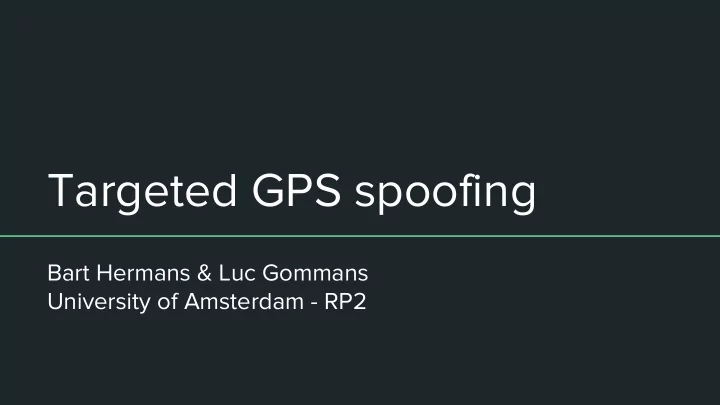

Targeted GPS spoofing Bart Hermans & Luc Gommans University of Amsterdam - RP2
How does GPS work? 2
How does GPS work? 3
4
How does GPS work? In reality: - You don't actually know the current time (third variable) - You don't know whether you are on the surface (fourth variable) - Time traveling - Due to the high speed and weaker gravity, time dilutes about 38µs a day faster - Stations on earth adjust this - Signal properties - Very, very low power ( ~ -166dBw when the signal hits the Earth's surface) 5
How does GPS spoofing work? ● Spoofing software calculates what you would receive on a certain position => ● Signal transmitted from a single antenna 6
Problem statement Move away GPS-assisted drones from locations such as: - Air ambulance landing site - Crowds - Airports (if the owner disabled geofencing) 7
Problem statement Currently: 8
Problem statement Currently: 9
Problem statement Target: 10
Problem statement 11
Problem statement 12
Research Question Principal research questions: Is it possible to limit GPS spoofing to a single receiver? Sub-questions: 1. Can a spoofed GPS signal be contained within a radius of 10 meters without the use of a Faraday cage? 2. Is it possible to direct spoofed GPS signals using a directional antenna? 3. Does the GPS receiver still compute an accurate position when dividing the spoofed GPS signal over two transmitters? 13
Scope - Off-the-shelf hardware - Use what can be delivered within a week - No antenna design - Focus on the transmitter's RF and spoofing properties - Leave the properties of the receiver as is. - Use the 1.8775 GHz frequency band for experiments - Only transmit with a maximum bandwidth of 4.5 MHz and ERP of 50 mW (regulations) - No experiments on the GPS frequency - No testing on commercial GPS receivers - No research on GNSS technologies other than civilian L1 GPS signal - No research on use cases of our research 14
Related Work - 2001 - Carles Fernandez-Prades et al. - GNSS-SDR: an open source tool for researchers and developers - 2005 - Hengqing Wen et al. - Countermeasures for GPS signal spoofing - 2011 - Nils Ole Tippenhauer et al. - On the requirements for successful GPS spoofing attacks - 2014 - Andrew J Kerns et al. - Unmanned aircraft capture and control via GPS spoofing 15
Experimental setup - Transmitting SDRs: 2x BladeRF x40 - Internal clock accuracy of 1 parts per million (ppm), calibrated with GSM before use - GPS spoofing software: GPS-SDR-SIM - Precomputed version for experiments with the antenna - Real-time version for the experiment with transmitting over multiple antennas - Receiving SDR: 1x HackRF One - GPS receiver software: GNSS-SDR - Antennas: 2x 2.4 GHz dipole and 2x 2.4 GHz Yagi-Uda 16
Experiment: directionality and range - Open field - To minimise reflection and interference - Compare monopole antenna with a directional Yagi-Uda antenna - Different distances (measured in steps of 100cm) - Different angles (measured in steps of 90 °) - Monopole ERPs: 18.6 mW and 11.7 mW - Yagi-Uda ERP: 46.1 mW 17
Experiment: multiple transmitters - Signal synchronisation - Dividing satellites' signals over multiple transmitters - 3 satellites per signal - Monopole ERP at 18.6 mW - Yagi-Uda ERP at 46.1 mW 18
Results: directionality and range 8dBm 10dBm (lower is better) 19
Results: directionality and range 20
Results: directionality and range Orientation 0° 90° 180° 270° Test run 1 56 seconds No fix obtained No fix obtained 175 seconds Test run 2 71 seconds 86 seconds No fix obtained 56 seconds 21
Results: directionality and range - Best signal at 0° - Side lobes are large, back lobe clearly smaller 22
Results: multiple transmitters - Modified the software to modulate only selected satellites per antenna - Signal synchronisation - First attempt not so successful... 23
24
Altitude: 118 000 km 25
6 370 km 26
International GPS satellites Space Station 20 000 km 370 km 27
Earth Calculated position Moon 188 000 km 363 000 km 28
Results: multiple transmitters - Signaling through FIFO pipe - FILE* tmpfile = fopen("/tmp/fifo", "r"); - mean 8.6µs, stddev 10µs, median 1.3µs - High-resolution clock - int status = clock_gettime(CLOCK_MONOTONIC, &result_time); - Busy wait: mean 8ns, stddev 6ns, median 6ns 29
Results: multiple transmitters ● Quite variable test runs 3D error (m) Horizontal error (m) Altitude error (m) Run 1 18 451 14 753 11 081 Run 2 250 235 87 Run 3 7 751 7 126 3 049 Run 4 4 440 4 075 1 764 Run 5 5 195 4 782 2 029 Run 6* 482 106 89 198 482 106 Run 7 9 552 8 773 3 778 30
Results: multiple transmitters - Error over time (monopole) of run 2 meters 31
Results: multiple transmitters - Error drift (monopole) 32
Results: multiple transmitters - Error over time (Yagi-Uda) 33 time (s)
Results: multiple transmitters - Error drift (Yagi-Uda) meters time (s) 34
Discussion - Different frequency band used. - 0.30208 GHz difference between 1.8775 GHz and 1.57542 GHz - 2.4 GHz antennas in our experimental setup - 1.8775 GHz (omni)directional antennas hard to find or didn't exist - Absence of a low noise amplifier (LNA) 35
Conclusion Is it possible to limit GPS spoofing to a single receiver? We failed to prove this, however: ● Dividing signals and time synchronisation works well ● Yagi-Uda antenna not adequate 36
Future work ● Different antenna with smaller side and back lobes ● Testing in a Faraday cage on the GPS frequency ● Low-noise amplifier ● Spoofing with the presence of the "genuine" signal 37
Questions 38
Recommend
More recommend